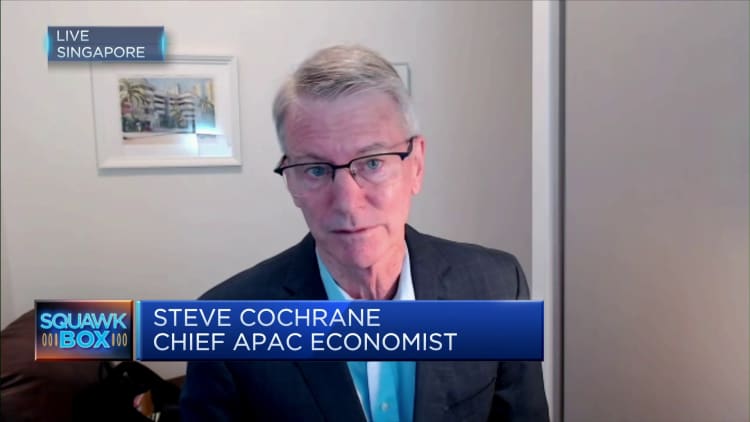
Just after a lot more than two several years of demanding Covid-19 border controls, Japan reinstated visa-no cost journey to 68 nations around the world on Tuesday.
Maki Nakamura | Digitalvision | Getty Photos
The Japanese yen’s slump in opposition to the U.S. greenback has sparked some worry in Japan, but that could inspire additional tourists to visit the place again, in accordance to analysts — although they say a important rebound in the tourism sector will not happen without having the return of Chinese tourists.
Right after a lot more than two many years of stringent Covid border controls, Japan reinstated visa-free of charge journey to 68 nations around the world on Tuesday.
Package deal excursions are no lengthier necessary, the Japan Countrywide Tourism Organization (JNTO) claimed.
The day by day entry restrict of 50,000 individuals and the on-arrival PCR test at the airport have been scrapped. On the other hand, it is nevertheless required for vacationers from all nations around the world and areas to post a negative Covid check certificate or evidence of vaccination, JNTO explained.
With the easing of limits and the depreciating yen, tourism to the country will return promptly — specially from Asia, mentioned Jesper Koll, director of financial expert services company Monex Group advised CNBC.
Koll claimed that although travelers from Europe and the U.S. are crucial in aiding Japan’s tourism recovery, “the bulk of the enthusiasm and the bulk of journey” continue to arrive from nations around the world like Singapore, the Philippines and Thailand.
“The cheapness of the yen of course raises the probability of tourism contributing enormously to the economic system,” Koll explained. “As the constraints get rolled again further, and the potential of inbound flights open up up, I assume that we will see inbound paying and inbound tourism accelerate really, very speedily.”

In 2019, Japan welcomed 32 million foreign website visitors and they expended about 5 trillion yen, but inbound paying out is now only just one-tenth of that, in accordance to a Goldman Sachs note from September.
The expense bank estimated that inbound shelling out could attain 6.6 trillion yen ($45.2 billion) just after a yr of whole reopening, as travelers will be encouraged to commit additional mainly because of the weak yen.
“Our ball-park estimation points to likely bigger inbound shelling out of ¥6.6 tn (annual) write-up total reopening compared to the pre-pandemic stage of ¥5 tn, partly aided by the weak yen,” the observe stated.
The Japanese currency plunged to a new 24-year low and was at 146.98 against the greenback during London’s buying and selling hrs on Wednesday.
Japanese officials intervened in the foreign exchange current market in September when the dollar-yen strike 145.9.
“I do not think the yen has been as low cost as it is now in dwelling memory,” explained Darren Tay, Japan economist at Cash Economics, explained on CNBC’s “Squawk Box Asia” on Tuesday. “Tourists had been presently clamoring for borders to reopen … So I think the weak yen will provide as a different motivating issue” for them to journey to Japan yet again.
While flight ticket selling prices to Japan have enhanced since the announcement was created, vacationers will continue to get a bang for their buck when they spend in Japan, Koll claimed.
“You can eat two times as a lot of hamburgers, two times as much sushi for your greenback here in Japan when compared to the United States, and even as opposed to the rest of Asia,” he included.
Chinese holidaymakers ‘hold the key’
The outlook for Japan’s tourism restoration appears to be promising, but “the all round impression on Japan’s economic system may well not be a internet positive” as Chinese vacationers have yet to return, Tay stated.
“Chinese holidaymakers basically make up a large volume of what overseas vacationers invested back again in 2019 … They’re continue to pursuing a zero-Covid technique so they won’t be returning anytime before long,” he mentioned.

Goldman Sachs claimed Chinese travelers, who designed up 30% of foreign people to Japan in 2019, could return only in the next quarter of 2023.
At the time China totally reopens, inbound expending from Chinese website visitors has the likely to boost from 1.8 trillion yen in 2019 to 2.6 trillion yen — .5% of Japan’s gross domestic products, mentioned Yuriko Tanaka, economist at Goldman Sachs.
“Chinese site visitors keep the critical to a bona fide rebound in inbound paying,” Tanaka stated.

With out site visitors from China, it could acquire some time just before inbound paying out in Japan returns to pre-pandemic levels, Koll mentioned. But robust demand from the rest of Asia could travel inbound expending to return “rather promptly” to more than $3 trillion by March 2023.
Outlook for yen
As markets count on the U.S. Federal Reserve to hike curiosity charges by 75 basis details in November, the yen will go on to weaken as the greenback continues to strengthen, reported Koll.
“You’ve got acquired the widening desire amount differential [between Japan and the U.S.], and the Federal Reserve is not finished however. There is at the very least one particular far more fascination fee hike in the cards,” he explained.
He additional that yen could weaken even more toward the 155 stage, strengthening only future spring — and that wouldn’t be the outcome of motion from Japan, but of the Fed signaling that it has “stepped more than enough on the brake.”







